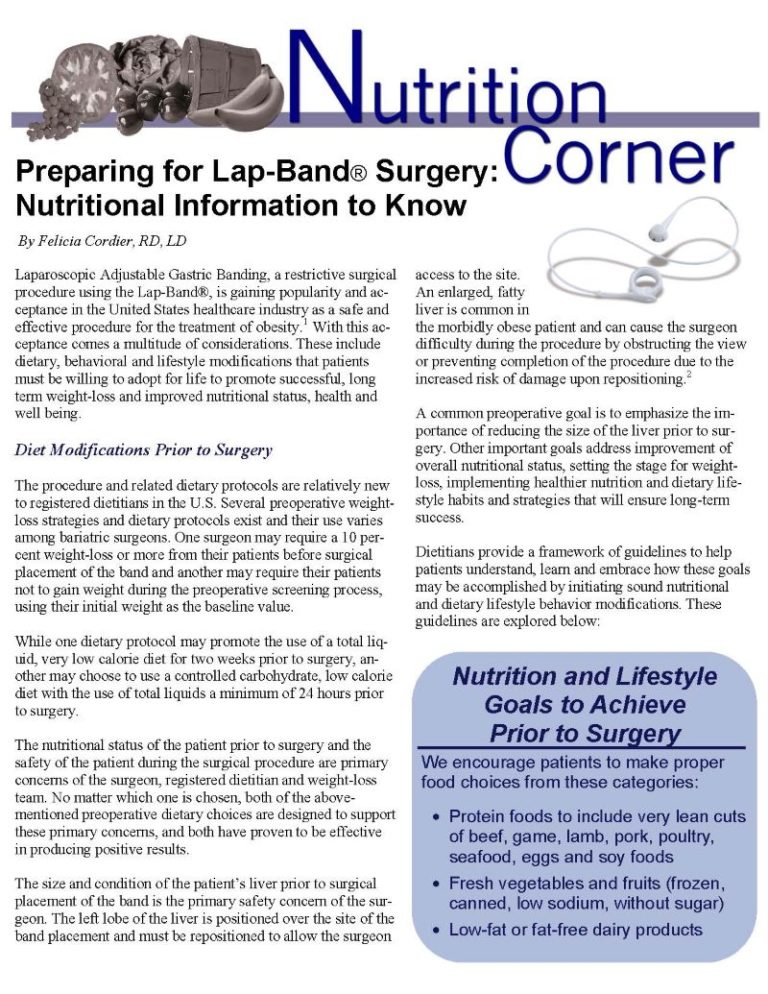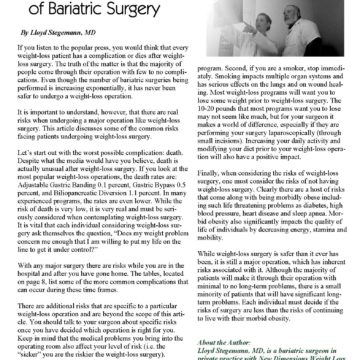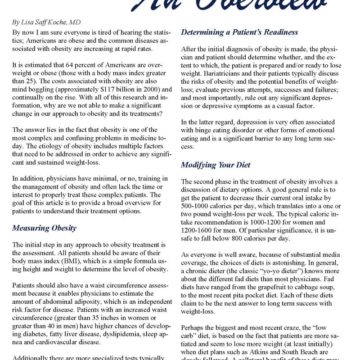Preparing for Lap-Band ® Surgery: Nutritional Information to Know


by Felicia Cordier, RD, LD
Fall 2005
Laparoscopic Adjustable Gastric Banding, a restrictive surgical procedure using the Lap-Band ®, is gaining popularity and acceptance in the United States healthcare industry as a safe and effective procedure for the treatment of obesity. 1 With this acceptance comes a multitude of considerations. These include dietary, behavioral and lifestyle modifications that patients must be willing to adopt for life to promote successful, long term weight-loss and improved nutritional status, health and well being.
Diet Modifications Prior to Surgery
The procedure and related dietary protocols are relatively new to registered dietitians in the U.S. Several preoperative weight-loss strategies and dietary protocols exist and their use varies among bariatric surgeons. One surgeon may require a 10 percent weight-loss or more from their patients before surgical placement of the band and another may require their patients not to gain weight during the preoperative screening process, using their initial weight as the baseline value.
While one dietary protocol may promote the use of a total liquid, very low-calorie diet for two weeks prior to surgery, another may choose to use a controlled carbohydrate, low-calorie diet with the use of total liquids a minimum of 24 hours prior to surgery.
The nutritional status of the patient prior to surgery and the safety of the patient during the surgical procedure are primary concerns of the surgeon, registered dietitian and weight-loss team. No matter which one is chosen, both of the above-mentioned preoperative dietary choices are designed to support these primary concerns, and both have proven to be effective in producing positive results.
The size and condition of the patient’s liver prior to surgical placement of the band is the primary safety concern of the surgeon. The left lobe of the liver is positioned over the site of the band placement and must be repositioned to allow the surgeon access to the site. An enlarged, fatty liver is common in a patient with severe obesity and can cause the surgeon difficulty during the procedure by obstructing the view or preventing completion of the procedure due to the increased risk of damage upon repositioning. 2
A common preoperative goal is to emphasize the importance of reducing the size of the liver prior to surgery. Other important goals address improvement of overall nutritional status, setting the stage for weight-loss, implementing healthier nutrition and dietary lifestyle habits and strategies that will ensure long-term success.
Dietitians provide a framework of guidelines to help patients understand, learn and embrace how these goals may be accomplished by initiating sound nutritional and dietary lifestyle behavior modifications. These guidelines are explored below:
The human body will experience uncomfortable symptoms such as fatigue and headaches when certain foods, such as bread and desserts, are eliminated from the diet, but those symptoms last only a few days. Eliminating some foods decreases the physical dependency on these foods.
This results in an increase in the patient’s energy level, an improvement in nutritional status and most importantly, a smaller liver. The following foods should be immediately eliminated after the first preoperative screening visit and continuing on through completion of surgery:
- Bread, rice, pasta and potatoes
- Crackers, chips, pretzels, or any other high-carbohydrate snack food
- Cookies, cakes, pies, candy or any sugar-sweetened food
- Sweetened drinks and full-strength juices
- Processed, fast, fried, breaded and saucy foods
Certain rules must be practiced prior to surgery to ensure success and to prevent possible complications, however more rules apply postoperatively: 3
- Cut food into small pieces and chew thoroughly.
- Eat slowly and pay attention to signs of fullness.
- Eliminate distractions while eating.
- Stop drinking 30 minutes before a meal and wait 30 minutes to drink after a meal.
It is noteworthy to reiterate that preoperative dietary protocols will vary among practitioners, and these protocols are effective in producing a positive result. The bariatric patient will benefit from explicitly following the dietary plan prescribed by their weight-loss team. Pre and postoperatively, if the patient embraces healthier dietary and lifestyle behaviors and they are empowered by a strong motivation and commitment to succeed, this indeed is the recipe for positive results and long term weight-loss success.
Nutritional and Lifestyle Goals to Achieve Prior to Surgery
We encourage patients to make proper food choices from these categories:
- Protein foods to include very lean cuts of beef, game, lamb, pork, poultry, seafood, eggs and soy foods
- Fresh vegetables and fruits (frozen, canned, low sodium, without sugar)
- Low-fat or fat-free dairy products
Tips to Help Initiate New Eating Habits
- Plan meals to ensure proper food choices
- Eat three meals a day at consistent times – no snacks
- Include protein foods with each meal
- Include unlimited non-starchy vegetables with at least two meals
- Include fruit once per day
- Limit starchy vegetables
- Limit overall carbohydrate intake to 20-30 grams per day (including dairy, fruit, and starchy vegetables)
- Drink at least 64 ounces of water daily (sugar-free beverages are allowed)
- Avoid the use of alcohol
- Begin taking a multivitamin and mineral and calcium supplement
- Keep a detailed record of all foods and drinks
- Initiate a minimum of 10 minutes of daily activity
Please Note: The information contained in this article is for educational purposes only and should not be substituted for medical advice or treatment from a healthcare professional. The OAC recommends consultation with your doctor or healthcare professional before initiating any dietary plans.
About the Author:
Felicia Cordier, RD, LD, is currently in private practice and owner of River City Nutrition in Jacksonville, FL. She is also a bariatric nutritionist for Jacksonville Weight-Loss Center.
References:
- Ponce , J., Paynter, S., and Fromm, R. Laparoscopic Adjustable Gastric Banding: 1,014 Consecutive Cases. J. Am. Coll. Surg., 2005; Vol. 201, No. 4, 529-535.
- Fris, R.J. Preoperative Low Energy Diet Diminishes Liver Size. 2004, Obesity Surgery, Vol. 14, 1165-1170.
- Inamed Corporation. Taking the Next Step, The Preferred Choice for the Surgical Treatment of Morbid Obesity booklet. 2004, page 10.
by Sarah Muntel, RD Spring 2024 Spring has sprung, bringing sunnier and warmer days! For many, this…
Read Articleby Kendall Griffey, OAC Communications Manager Spring 2024 We have officially kicked off Your Weight Matters Regional…
Read Articleby OAC Staff Members Kendall Griffey and Michelle “Shelly” Vicari Winter 2024 In a world that often…
Read Article








